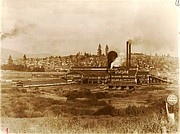Idaho’s lumber industry is more consolidated than ever, and making billions in sales
In Idaho’s nearly 150 years of history with the lumber industry, the trade has transformed from a wide scattering of communities built and centered around logging and mills, to the more consolidated forestry seen today.
After the forests around the Great Lakes were depleted in the early 1900s, there were two places for the timber industry to turn for materials needed for a swiftly growing America: the South and the Pacific Northwest.
The then-and-now of Idaho’s forest products
Rathdrum, Sandpoint, Kootenai and other towns in North Idaho were founded with logging in mind because of the massive amount of lumber available in the expansive old-growth forests.
The first sawmill in North Idaho was built in 1878 by the U.S. Army, near the Spokane River at what is now Fort Sherman, according to the Museum of North Idaho.
Near Sandpoint in 1900, Humbird Lumber Co. began its venture. Over the next three decades, it grew to three sawmills, owning over 200,000 acres of forest land. When the Great Depression hit the U.S., it took a toll on the lumber industry, and Humbird Lumber Co. was forced to liquidate its assets.
The rest of the 20th Century put the Idaho lumber industry through ups and downs, booms and closures, and consolidation as a means of survival.
Merging and closing is part of the lumber business, especially now
The Clearwater Timber Co. began around the same time as Humbird but was incorporated in 1903 into the Potlatch Lumber Co. — well known throughout North Idaho today. PotlatchDeltic is now the largest private landowner in Idaho, with 626,000 acres of timberland.
PotlatchDeltic’s beginnings are rooted on the edges of the Palouse region in the town of Potlatch, where the company built its first sawmill, the world’s largest white pine sawmill until the company closed it in 1983, according to Intermountain Histories.
The closing of sawmills isn’t something left in the previous century.
During the 2008 recession and housing market crash, the lumber industry took a major hit. Many mills were forced to close their doors or limit operations.
In 2006, there were 88 active forest products plants in Idaho, according to the U.S. Department of Agriculture. By 2011, 26 of those were no longer active, and every other plant had a temporary closure between 2007 and 2011.
After recovering from the economic crisis of the late 2000s, the state’s timber industry made a slow comeback. It was still slowly gaining traction by 2013.
Idaho produced 247 million board feet in timber in 2020, according to the Idaho Department of Lands 2020 annual report.
Lack of steady supply hits small communities the hardest
More recently, in 2016, two sawmills along the Clearwater River closed their doors.
TriPro Forest Products had purchased the Konkolville Lumber Co. in Orofino in 2011. It was one of the largest private employers in Clearwater County at the time, as reported by the Lewiston Tribune. But the mill didn’t survive the next decade.
The Orofino mill shut down after a federal judge halted the salvage of timber in the wake of the Johnson Bar Fire. Friends of the Clearwater, a local environmental group, and Idaho Rivers United had sued over the salvage logging project, according to reporting from the Idaho County Free Press. Mike Reggear, resource manager for Tri-Pro Mill at the time of its closure, told the Clearwater Tribune there were roughly 50 jobs lost when the mill shut down.
Around the same time, Blue North in Kamiah approached Idaho Forest Group about buying out its assets and informed over 60 employees that their mill in Kamiah would be shutting down for good due to an unstable supply of lumber.
Small operations closing hasn’t shown a statewide impact yet
However, the decreasing number of sawmills doesn’t mean the lumber industry isn’t contributing to Idaho’s economy.
In 2017, direct employment in Idaho’s forest industry was estimated at 14,090 jobs, according to a 2018 report. That number increased to 16,200 by 2020, according to a 2021 report.
Shawn Keough, a former Idaho state senator and executive director of the Associated Logging Contractors, said employment has remained stable for most of the forest product industry.
The amount of money the forest products industry brings to Idaho didn’t plummet because of mill closures, either. In 2020, more than $3 billion in product sales was brought to the state despite the impacts of COVID-19, according to a 2021 report.
For comparison, Idaho’s inflation-adjusted timber sales in 2011 were about $1.85 billion.
The amount of product being processed remains steady despite pandemic-related supply chain issues as well.
Scott Phillips, policy and communications chief for the Idaho Department of Lands, said the amount of timber being cut hasn’t changed drastically since before the closures of several mills across North Idaho. Instead, he said, it’s being sold to a smaller pool of large purchasers, like Idaho Forest Group and PotlatchDeltic.



